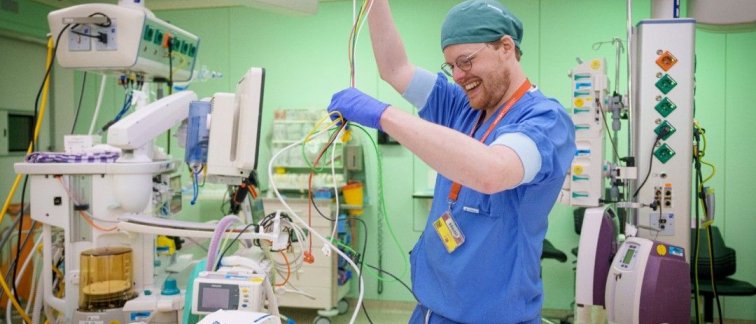Health minister Ernst Kuipers has posted an interesting article on sustainability in healthcare. He talks about APH researcher Niek Sperna Weiland and his work on making the Amsterdam UMC more sustainable.
Minister Ernst Kuipers says: “Next week is Duurzame Dinsdag (Sustainable Tuesday). A day when sustainable ideas and initiatives get a stage in political The Hague. Sustainability in healthcare is important, because healthcare is responsible for about 7 to 8 percent of CO2 emissions in The Netherlands. It is good to see that the sector is working in many ways to reduce the negative impact of healthcare on our climate and environment. I also want sustainability to become a standard part of our policy within the Ministry of Health, Welfare and Sport.”
Ernst Kuipers starts with introducing APH researcher Niek Sperna Weiland. Sperna Weiland is an anesthesiologist at Amsterdam UMC and one of the driving forces behind reducing the use of anesthetic gases in Dutch hospitals. His passion for sustainability started during his specialization in exchange with a New York hospital. There, he saw how you can contribute to making healthcare more sustainable and thus be of real value in combating climate change, as an anesthesiologist. Because healthcare cannot and must not look away anymore. Climate change has a major impact on public health and, as doctors, we have a responsibility to combat it and thus (indirectly) promote public health, Niek believes.
At the Amsterdam UMC he was given the opportunity to work with a Green Team to make the operating room (OR) more sustainable, and he seized that opportunity with both hands. Because if there is one place where improvements can be made, it's in the operating room, which is the most environmentally harmful place in the hospital. The OR uses three to six times more energy per square meter than the rest of the hospital. It is also a huge consumer of disposables: one-third of all hospital waste comes from the OR. And in anesthesia, strong greenhouse gases are used as anesthetic drugs. The latter is where Niek immediately got to work.
Gaseous anesthetics are used when sedating patients for surgery. After use, these gases enter the atmosphere, where they retain an awful lot of heat. In comparison, 1 kilogram of the anesthetic gas desflurane in the atmosphere is equivalent to almost 7,000 kilograms of CO2 in terms of effect. It is therefore very important that we prevent the release of these powerful greenhouse gases as much as possible. This can be done, for example, by not anesthetizing patients with narcosis gas, but via IV. This makes no difference for the patient (indeed, they experience less nausea after the anesthesia) and it requires a slightly different procedure from the anesthesiologist. But it does prevent this greenhouse gas from being released into the atmosphere and causing a lot of damage. Niek set to work to make fellow anaesthesiologists both inside and outside his hospital aware of this. And with great success: at the Amsterdam UMC, the emission of narcosis gases has been reduced by 70%, and The Netherlands are now far ahead of other countries: narcosis gases already seem to be less of a problem in the Netherlands than in the countries around us.
But that doesn't mean we're already there. Niek still sees a lot of room for improvement in the OR and beyond. Not just in the area of narcosis gas emissions, but also in electricity consumption and the use of disposable materials. For example, he is currently investigating how the air treatment installation in the OR can be used more efficiently and he has collaborated on the design of a washable OR cap that will replace the disposable cap. Niek is certainly not finished yet!
Read the full article (in Dutch) here: Duurzame dinsdag: minder uitstoot bij narcose | LinkedIn
Health Minister Ernst Kuipers will talk about sustainability in healthcare every Tuesday on LinkedIn.

